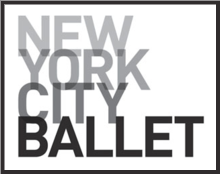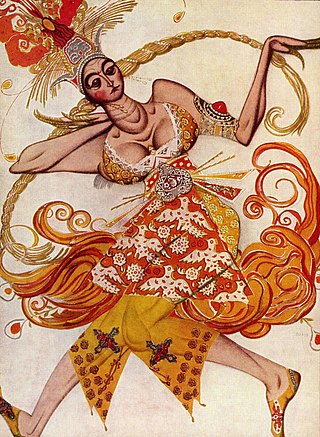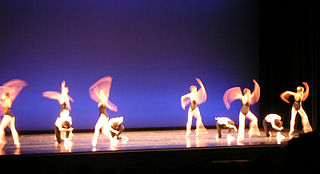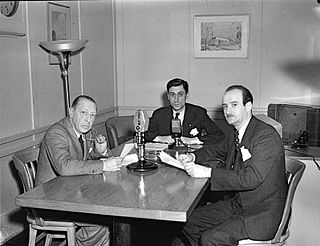Ragtime is a style of music.

George Balanchine was a Georgian-American ballet choreographer, recognized as one of the most influential choreographers of the 20th-century. Styled as the father of American ballet, he co-founded the New York City Ballet and remained its artistic director for more than 35 years. His choreography is characterized by plotless ballets with minimal costume and décor, performed to classical and neoclassical music.

New York City Ballet (NYCB) is a ballet company founded in 1948 by choreographer George Balanchine and Lincoln Kirstein. Balanchine and Jerome Robbins are considered the founding choreographers of the company. Léon Barzin was the company's first music director. City Ballet grew out of earlier troupes: the Producing Company of the School of American Ballet, 1934; the American Ballet, 1935, and Ballet Caravan, 1936, which merged into American Ballet Caravan, 1941; and directly from the Ballet Society, 1946.

The Firebird is a ballet and orchestral concert work by the Russian composer Igor Stravinsky. It was written for the 1910 Paris season of Sergei Diaghilev's Ballets Russes company; the original choreography was by Michel Fokine, who collaborated with Alexandre Benois and others on a scenario based on the Russian fairy tales of the Firebird and the blessing and curse it possesses for its owner. It was first performed at the Opéra de Paris on 25 June 1910 and was an immediate success, catapulting Stravinsky to international fame and leading to future Diaghilev–Stravinsky collaborations including Petrushka (1911) and The Rite of Spring (1913).
Histoire du soldat, or Tale of the Soldier, is an hour-long 1918 theatrical work to be "read, played and danced (lue, jouée et dansée)" by three actors, one or more dancers, and a septet of instruments. Its music is by Igor Stravinsky, its libretto, in French, by Swiss writer Charles Ferdinand Ramuz; the two men conceived it together, their basis being the Russian tale The Runaway Soldier and the Devil in the collection of Alexander Afanasyev.
Le Baiser de la fée is a neoclassical ballet in one act and four scenes composed by Igor Stravinsky in 1928 and revised in 1950 for George Balanchine and the New York City Ballet. Based on Hans Christian Andersen's short story Isjomfruen, the work is an homage to Pyotr Ilyich Tchaikovsky, for the 35th anniversary of the composer's death. Stravinsky elaborated several melodies from early piano pieces and songs by Tchaikovsky in his score. A commission by Ida Rubinstein from 1927, the ballet was choreographed by Bronislava Nijinska and premiered in Paris on 27 November 1928.

Apollo is a neoclassical ballet in two tableaux composed between 1927 and 1928 by Igor Stravinsky. It was choreographed in 1928 by twenty-four-year-old George Balanchine, with the composer contributing the libretto. The scenery and costumes were designed by André Bauchant, with new costumes by Coco Chanel in 1929. The scenery was executed by Alexander Shervashidze, with costumes under the direction of Mme. A. Youkine. The American patron of the arts Elizabeth Sprague Coolidge had commissioned the ballet in 1927 for a festival of contemporary music to be held the following year at the Library of Congress in Washington, D.C.

Agon is a 22-minute ballet for twelve dancers with music by Igor Stravinsky. It was choreographed by George Balanchine. Stravinsky began composition in December 1953 but was interrupted the next year; he resumed work in 1956 and concluded on April 27, 1957. The music was premiered in Los Angeles at UCLA's Royce Hall on June 17, 1957, conducted by Robert Craft. Stravinsky himself conducted the sessions for the work's first recording the following day on June 18, 1957. Agon was first performed on stage by the New York City Ballet at the City Center of Music and Drama on December 1, 1957.
Tango is a ballet made by New York City Ballet co-founder and founding choreographer George Balanchine to Stravinsky's Tango (1940) arranged 1953 by the composer. The premiere took place June 10, 1982, as part of City Ballet's Stravinsky Centennial Celebration at the New York State Theater, Lincoln Center.
The Suzanne Farrell Ballet is a ballet company housed at the Kennedy Center, Washington, D.C., and founded in 2000 by Suzanne Farrell, one of George Balanchine's most celebrated ballerinas, and a former New York City Ballet principal dancer. Until 2017, the Suzanne Farrell Ballet was a full-fledged company produced by the Kennedy Center and had performed there since 1999 in addition to presenting extensive national and international tours. In September 2016, the Center announced that the company would be disbanding at the end of 2017, citing "possibilities of new expansion" and indicating that Farrell would likely return to "full-time teaching."
Circus Polka: For a Young Elephant was written by Igor Stravinsky in 1942. He composed it for a ballet production that the choreographer George Balanchine did for Ringling Bros. and Barnum & Bailey Circus. The ballet was performed by fifty elephants and fifty ballerinas. In 1944, Stravinsky published an orchestration of the piece, which is now part of the repertoire of many orchestras.
Symphony in Three Movements is a neoclassical ballet choreographed by George Balanchine to the music of the same name by Igor Stravinsky. The ballet was made for the New York City Ballet Stravinsky Festival in 1972, a tribute to the composer following his death. The ballet premiered on June 18, 1972, at the New York State Theater.
Orpheus is a thirty-minute neoclassical ballet in three tableaux composed by Igor Stravinsky in collaboration with choreographer George Balanchine in Hollywood, California in 1947. The work was commissioned by the Ballet Society, which Balanchine founded together with Lincoln Kirstein and of which he was Artistic Director. Sets and costumes were created by Isamu Noguchi.
Elegy is a composition by Igor Stravinsky for solo viola composed in 1944. It was dedicated to the memory of Alphonse Onnou, the founder of the Pro Arte Quartet. The score bears no time signature, but the metronome marking sets the tempo at = 56. The opening section is in the style of a chant above a rippling accompaniment. The middle section contains elements of a fugue, though there are never more than two independent voices. After its climax, the Elegy closes with a recapitulation of its opening. The viola is directed to play with mute throughout.
Variations is a ballet made by New York City Ballet co-founder and founding choreographer George Balanchine to Stravinsky's Variations: Aldous Huxley in memoriam (1963–64). The premiere took place on Thursday, 31 March 1966 at the New York State Theater, Lincoln Center; Balanchine made a new version for City Ballet's 1982 Stravinsky Centennial Celebration.
Ragtime (I) is the second of three ballets made by New York City Ballet's co-founder and balletmaster George Balanchine to Igor Stravinsky's 1918 Ragtime for Eleven Instruments; with scenery by Robert Drew previously used for Lew Christensen's 1947 work for Ballet Society, Blackface; costumes by Karinska and lighting by David Hays. The premiere took place on December 7, 1960, at City Center of Music and Drama, conducted by Robert Irving, as part of a quartet of works titled Jazz Concert, together with dances by Todd Bolender's Creation of the World, Francisco Moncion's Les biches and John Taras' Ebony Concerto. Balanchine's 1966 Ragtime (II) was also made for City Ballet; his previous ballet to Stravinsky's Ragtime was one of a number of "informal little things" made in St. Petersburg in 1922.

Igor Stravinsky wrote the Ebony Concerto in 1945 for the Woody Herman band known as the First Herd. It is one in a series of compositions commissioned by the bandleader and clarinetist featuring solo clarinet, and the score is dedicated to him. It was first performed on March 25, 1946 in Carnegie Hall in New York City, by Woody Herman's Band, conducted by Walter Hendl.
Scènes de ballet is a suite of dance movements composed in 1944 by Igor Stravinsky. It was commissioned by Broadway producer Billy Rose for inclusion in the revue The Seven Lively Arts that opened at the Ziegfeld Theater on December 7, 1944.
Stravinsky Violin Concerto, originally titled Violin Concerto, is a neoclassical ballet choreographed by George Balanchine to Stravinsky's Violin Concerto. Balanchine had previously choreographed another ballet to the concerto in 1941 for the Original Ballet Russe, titled Balustrade, though it was not revived following a few performances. He then reused the concerto for New York City Ballet's Stravinsky Festival in 1972, a tribute to the composer following his death. The ballet premiered on June 18, 1972, at the New York State Theater.
Duo Concertant is a ballet choreographed by George Balanchine to Stravinsky's score of the same name. The ballet was created for New York City Ballet's Stravinsky Festival, a tribute to the composer a year after his death, and premiered on June 22, 1972, at the New York State Theater, danced by Kay Mazzo and Peter Martins.





